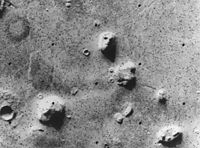Cydonia (Mars)

Cydonia Mensae is an albedo feature (region) on Mars. It lies in the planet's northern hemisphere in a transitional zone between the heavily-cratered regions to the south and relatively smooth plains to the North. Cydonia itself is covered in numerous mesas and may have been a coastal zone if planetologists are correct in believing that the northern plains were once ocean beds.
One of the Cydonian mesas, situated at roughly 40.9 degrees North latitude and 9.45 degrees West longitude, took on the striking appearance of a human Face on Mars in a photo taken by Viking 1 in 1976. Whilst generally believed to be an optical illusion (pareidolia), others view it as evidence of a long-lost Martian civilization. Other features are argued to have been observed, such as apparent pyramids. A popular belief is that these are part of a ruined city. NASA has stated however that "a detailed analysis of multiple images of this feature reveals a natural looking martian hill whose illusory face-like appearance depends on viewing angle and angle of illumination." [1]. More recent pictures by the Mars Global Surveyor seem only to confirm the validity of this scientific opinion (for example [2] in 1998, [3] in 2001). (Also see [4] for a close-up from 2001 and [5]).
Eighteen images of the Cydonia Mensae region were taken by the Viking 1 and 2 orbiters, but only seven have resolutions better than 250 m/pixel. The other eleven images have resolutions worse than 550 m/pixel and are virtually useless for studying the "feature". Of the seven good images, the lighting and time at which two pairs of images were taken are so close as to reduce the number to five usable, distinct images. The Mission to Mars: Viking Orbiter Images of Mars CD-ROM image numbers are: 35A72 (VO-1010), 70A13 (VO-1011), 561A25 (VO-1021), 673B56 & 673B54 (VO-1063), and 753A33 & 753A34 (VO-1028).
Trivia
- An abandoned alien base was found on Cydonia in the video game Zak McKracken and the Alien Mindbenders
- The final battle ("Cydonia or Bust") of the first X-COM game is fought in an active alien base in the Cydonia region, as the area is revealed to be the origin of the alien threat featured in the game
- The animated series Invader Zim features Cydonia in one episode as the ruins of a civilization that turned the planets Mars and Mercury into spaceships
- In the computer game Corridor 7: Alien Invasion the artifact which activates a dimensional gate leading to Earth invasion was retrieved from "an area near one of Mars' curious face-like formations"
- Bal-Sagoth, an English avant-garde epic metal band, has a song entitled Beneath The Crimson Vaults Of Cydonia on their sixth album The Chthonic Chronicles. The song posits that the Face on Mars and other buildings on Mars were built by demon-like extradimensional currently dormant in subterranean crypts.
- Coincidentally, the Doctor Who serial "Pyramids of Mars", features (as the name suggests) Martian pyramids, but was broadcast before the Viking images were taken. The Doctor Who spin-off novels have since connected the story with Cydonia.
- American band Crimson Glory recorded the song Cydonia on their album "Astronomica".
- The British band Muse have a song named "Knights of Cydonia" on their 2006 album titled Black Holes and Revelations.
- The 2000 movie "Mission to Mars" featured a face on the planet mars, which was later revealed to be an ancient alien structure. No pyramids were featured.
- The British band The Orb released an album called Cydonia in 2001.
- Jim Denney has written a book in his Timebenders series for young readers entitled "Lost in Cydonia".
- In the animated television show Futurama, the great stone face of Mars is home to Martian natives. It is also mentioned there is a great stone ass on the other side of the planet.
- The location of Cydonia on mars is said to match that of Stone Henge in England.
See also
External links
- Discussion of MOC and "Face on Mars" From Malin Space Science Systems (MSSS), regarding history, acknowledgement of conspiracy theories, and plans for the Mars Global Surveyor Orbiter Camera. See also MSSS's Face on Mars images and videos
- Hoagland at UN - Cydonia Connection - A very interesting Conference Video held at the UN about the Mars Cydonia area and its connection with structures here on Earth in Egypt. The Pyramids, Sphynx and more.
- Hoagland discussion/debunking at Bad Astronomy - A discussion of the science and pseudoscience of Cydonia.
